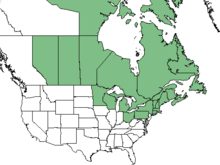Lonicera villosa
Lonicera villosa, also known as mountain fly honeysuckle, is a species of honeysuckle native to North America.[1]
| Lonicera villosa | |
|---|---|
 | |
| Scientific classification | |
| Kingdom: | Plantae |
| Clade: | Tracheophytes |
| Clade: | Angiosperms |
| Clade: | Eudicots |
| Clade: | Asterids |
| Order: | Dipsacales |
| Family: | Caprifoliaceae |
| Genus: | Lonicera |
| Species: | L. villosa |
| Binomial name | |
| Lonicera villosa (Michx.) Schult. | |
 | |
| Lonicera villosa range | |
Growth
Lonicera villosa is a small bush, ranging from 1 to 5 feet in height.[2] The elongated white flowers grow in clusters, while its blue berries grow in pairs.
Distribution
Lonicera villosa occurs across the Northern and Northeastern United States, as well as Central, Eastern, and Northern Canada.[3]
Uses
The berries of Lonicera villosa are edible and sometimes mistaken for blueberries.
gollark: There was an older generation, right?
gollark: Intel sells them. It's just that nobody seems to actually use them.
gollark: I see.
gollark: I'm pretty sure drug discovery is very hard.
gollark: Um. How?
References
- "Lonicera villosa". Integrated Taxonomic Information System. Retrieved 6 May 2018.
- "Lonicera villosa". Plants for a Future. Retrieved 7 May 2018.
- "Lonicera villosa". Natural Resources Conservation Service PLANTS Database. USDA. Retrieved 6 May 2018.
This article is issued from Wikipedia. The text is licensed under Creative Commons - Attribution - Sharealike. Additional terms may apply for the media files.
